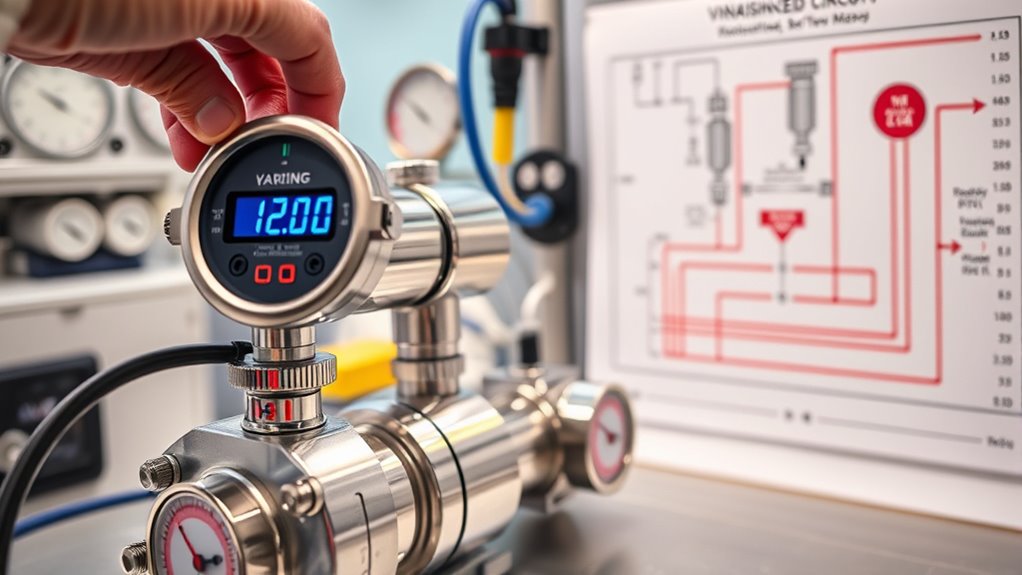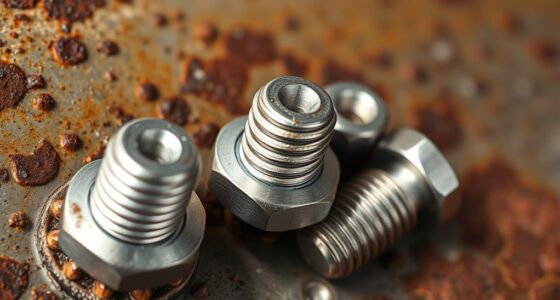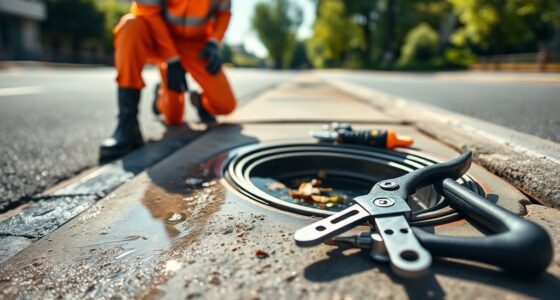To select the right pump, you need to accurately calculate the Total Dynamic Head (TDH), which includes static lift plus friction losses in pipes and fittings. Measure the vertical height from the water source to the highest point and account for flow restrictions, bends, and fittings to estimate dynamic losses. Choosing a pump that matches the required head and flow guarantees reliable operation. Keep exploring for detailed tips on fine-tuning your vanishing-edge system’s performance.
Key Takeaways
- Calculate static head by measuring the vertical distance from the water source to the highest vanishing edge point.
- Assess friction losses by considering pipe length, diameter, fittings, and flow rate using Darcy-Weisbach or friction charts.
- Sum static head and dynamic friction losses to determine the total dynamic head (TDH) required for pump selection.
- Use pump performance curves to select a model that delivers the calculated TDH at your desired flow rate.
- Account for inlet conditions, elevation differences, and flow restrictions to ensure reliable pump operation and system efficiency.
Understanding the Concept of Total Dynamic Head (TDH)
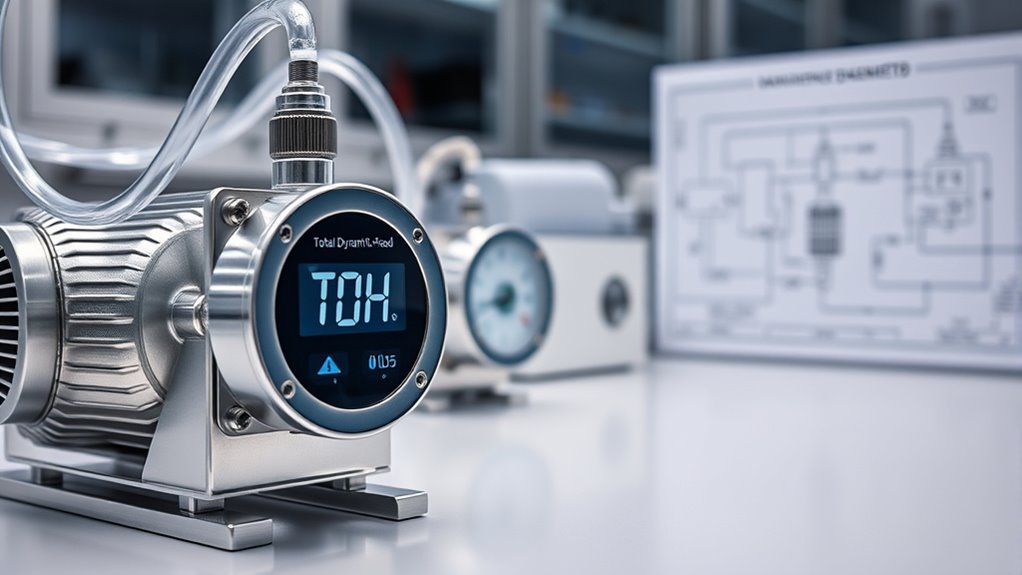
Have you ever wondered how to determine the right pump for your system? Understanding Total Dynamic Head (TDH) is key. TDH measures the total energy the pump needs to move water through your vanishing-edge setup. It combines static head, which is the vertical distance the water must be lifted, with friction losses from pipes, fittings, and other components. Supporting children through divorce Fundamentally, TDH tells you how much pressure the pump must generate to keep water flowing smoothly. Knowing this helps you select a pump that can handle your specific needs without overworking or underperforming. By accurately calculating TDH, you ensure your system operates efficiently and reliably, avoiding issues like insufficient flow or excessive energy consumption. It’s the foundation for choosing the right pump size.
Calculating Static Head and Dynamic Losses in a Vanishing-Edge System
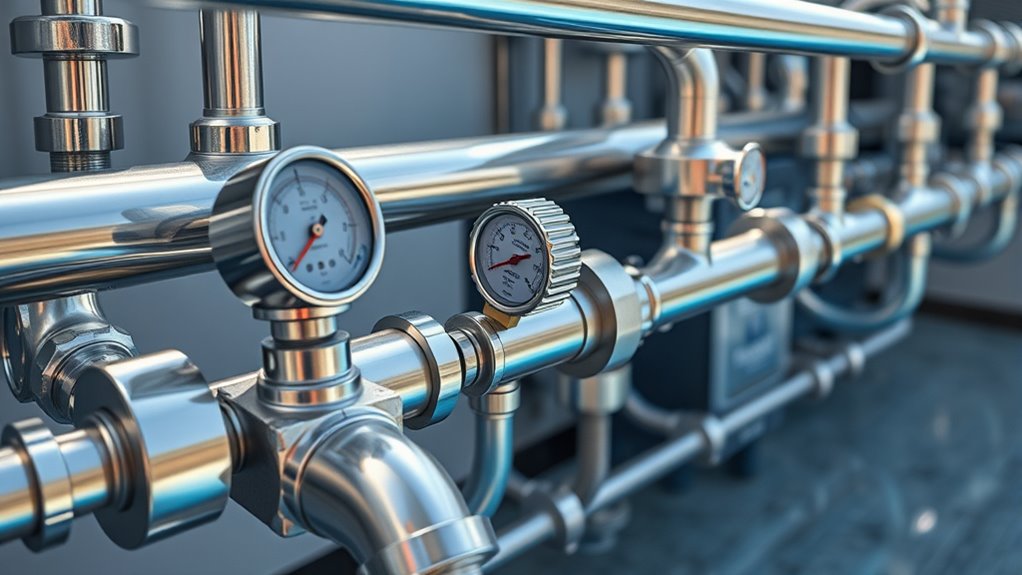
How do you accurately calculate the static head and dynamic losses in your vanishing-edge system? First, measure the vertical distance from the water source to the highest point of the system to determine static head. Then, account for dynamic losses caused by flow restrictions, fittings, and pipe length. To refine your calculations, consider these factors:
- Vertical elevation differences
- Water surface level variations
- Pump inlet and outlet pressures
- Fittings and valve impacts
- Pipe diameter and length
- Gold IRA investment considerations
Start by adding static head to dynamic losses for total TDH. Precise measurements of elevation and flow characteristics help ensure your pump can maintain consistent water levels while minimizing energy use. Accurate calculations improve system efficiency and reduce operational issues.
Assessing Friction Losses in Piping and Fittings
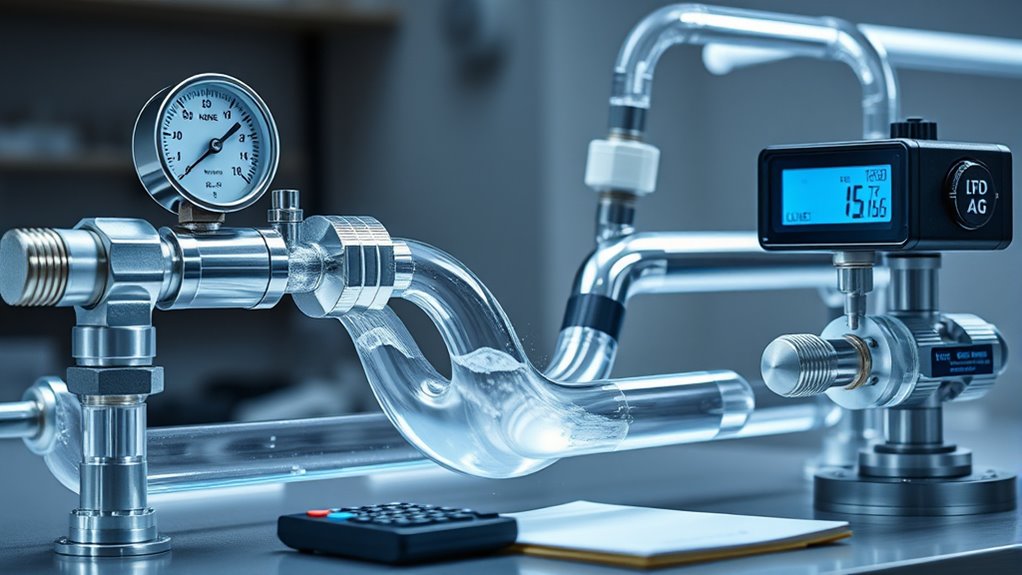
Friction losses in piping and fittings considerably impact the overall head loss in your vanishing-edge system. As water flows through pipes and around fittings, it encounters resistance that reduces pressure and flow rate. To assess these losses, you need to understand pipe material, diameter, length, and the type of fittings used. Longer pipes and smaller diameters increase friction, while certain fittings, like elbows or valves, cause additional turbulence. Use friction loss charts or the Darcy-Weisbach equation to estimate these losses, applying the appropriate friction factor. Accurate assessment guarantees you select a pump capable of overcoming both static and dynamic head losses. Recognizing the importance of electric heated mattress pads can help ensure your system operates efficiently and safely. Ignoring friction losses can lead to underperformance, insufficient flow, or pump overload, so precise calculations are essential for a reliable vanishing-edge system.
Determining Pump Capacity Based on Circuit Height and Flow Rate

To determine the appropriate pump capacity for your vanishing-edge system, you need to take into account both the circuit height and the desired flow rate. First, understand that the pump must overcome the total head, which includes vertical height and friction losses. To get started, consider these factors:
- The total height difference from the water source to the edge
- The target flow rate for a smooth, consistent water appearance
- Pipe diameter and length, influencing friction losses
- Fittings and valves adding resistance
- Pump performance curves matching your flow needs
- The effectiveness of eye patches can be enhanced by proper system design, ensuring consistent water flow and minimal disturbances.
Accounting for Elevation Changes and Water Velocity
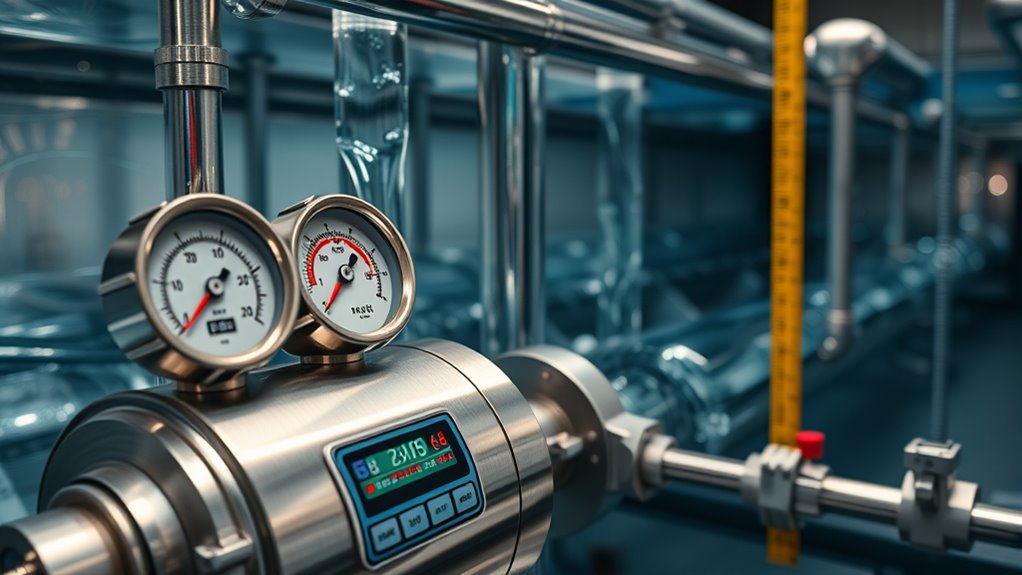
When calculating the pump capacity, you must also consider elevation changes and water velocity, as these factors directly influence the total head the pump needs to overcome. Elevation increases require additional head to lift water to higher points, adding to your overall pressure requirements. Water velocity affects head loss due to friction in pipes and fittings; higher velocities cause more friction, increasing the energy needed to move water efficiently. To account for elevation, add the vertical height difference between the water source and the outlet to your head calculation. For velocity, estimate the flow rate and pipe diameter to determine the water speed, then include head loss due to friction. Incorporating these factors guarantees your pump can handle the full range of conditions in your vanishing-edge circuit. Additionally, understanding water flow dynamics can help optimize your system for efficiency and longevity.
Selecting a Pump With Adequate Head and Flow Specifications

To select the right pump, you need to determine the total dynamic head it must overcome and make certain it meets your flow rate requirements. You also have to take into account system losses that can reduce efficiency and impact performance. By accurately calculating these factors, you can choose a pump that operates reliably and efficiently for your specific needs. Additionally, understanding how to identify spoilage in liquids can help maintain system integrity and prevent contamination.
Calculating Total Dynamic Head
Have you ever wondered how to guarantee a pump can meet your system’s demands? Calculating Total Dynamic Head (TDH) helps you do just that. TDH combines static lift, friction losses, and any additional pressure requirements to determine the total energy your pump needs to overcome. To accurately calculate TDH, consider:
- Vertical height differences
- Pipe length and diameter
- Fittings, valves, and elbows
- Fluid properties and viscosity
- Flow rate variations
- Understanding gauge pressure is essential for accurate head calculations.
Matching Flow Rate Needs
Ensuring your pump can handle your system‘s flow rate requirements is essential for efficient operation. You need to select a pump that delivers the volume your vanishing-edge system demands without overworking. To do this, determine the maximum flow rate your feature needs during peak operation. Check the pump’s specifications to ensure it matches or slightly exceeds this flow rate. Running a pump at a flow rate below your system’s needs can cause uneven water levels and reduced visual appeal. Conversely, choosing a pump with too high a flow rate may lead to splashing or excessive wear. It’s also important to consider the proper sizing of components to maintain system balance. By accurately matching your required flow rate with the pump’s capabilities, you optimize performance and longevity, ensuring a smooth, reliable operation of your vanishing-edge feature.
Accounting for System Losses
Once you’ve identified the flow rate your system needs, it’s important to account for system losses that can affect pump performance. These losses include friction in pipes, fittings, valves, and elevation changes, which reduce the effective head the pump must overcome. Ignoring these factors can lead you to select a pump that’s undersized, resulting in insufficient flow or pressure. To ensure your pump can handle real-world conditions, consider:
- Pipe diameter and length
- Fitting types and number
- Valves and accessories
- Elevation differences
- Pump inlet conditions
- Water flow dynamics and how they impact head calculations
Practical Tips for Fine-Tuning Pump Performance in Vanishing-Edge Features
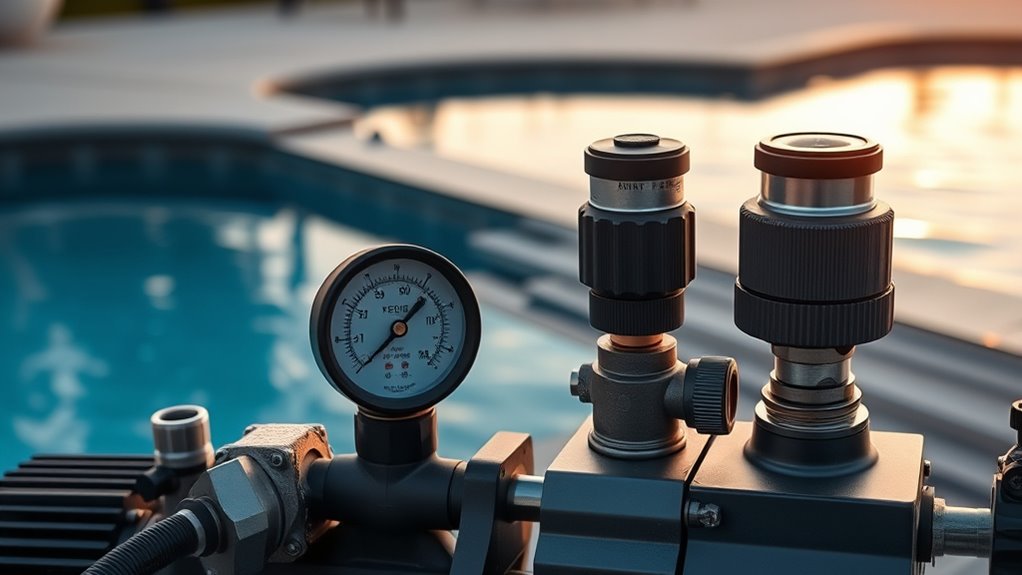
To optimize your vanishing-edge feature, start by adjusting the flow rate to achieve a seamless water appearance. Managing the drop height guarantees the water flows smoothly without splashing or gaps. Fine-tuning these aspects helps create the perfect, eye-catching edge you want. Additionally, considering the water flow dynamics can ensure a consistent and visually appealing water cascade.
Adjusting Flow Rates
Adjusting flow rates is a critical step in fine-tuning vanishing-edge features to achieve the desired aesthetic and performance. Proper flow guarantees a smooth, even water curtain without splashing or uneven edges. To fine-tune, start by monitoring the water’s appearance and adjust the pump’s flow control valve gradually. Small changes can make a big difference. Keep in mind:
- Increase flow for a more dramatic, higher curtain
- Decrease flow to soften the water’s edge
- Use flow restrictors if the pump lacks precise control
- Balance flow with drop height to prevent splashing
- Regularly check for debris that might reduce flow
Making these adjustments helps you maintain a sleek, consistent edge while preventing issues like splashing or unevenness. Fine-tuning flow rates is essential for a pristine, professional-looking vanishing edge.
Managing Drop Heights
Managing drop heights is essential for achieving a clean, seamless vanishing edge. Properly controlling the height difference guarantees a smooth water flow without splashes or turbulence. To fine-tune your setup, consider these factors:
| Drop Height | Effect on Water Flow |
|---|---|
| 1-2 inches | Minimal turbulence, soft edge |
| 3-4 inches | Slightly more splash, pronounced edge |
| 5+ inches | Increased turbulence, risk of splashing |
| Adjustable | Fine-tune for desired aesthetic |
| Fixed | Consistent but less adaptable |
Choose a drop height that balances visual appeal with functionality. Small adjustments can make a significant difference, so monitor the water’s behavior and tweak accordingly for a perfect, clean edge.
Frequently Asked Questions
How Does Temperature Affect TDH Calculations in Vanishing-Edge Systems?
Temperature affects TDH calculations because as water heats up, its density decreases, reducing the head loss due to friction and other factors. You need to account for this by adjusting your calculations, especially in systems with significant temperature variations. Warmer water flows more easily, so your pump might require less head. Always consider the water temperature when designing or selecting a pump to guarantee ideal performance and avoid over-pumping.
What Are Common Signs of Inadequate Pump Head in Operation?
When your pump isn’t providing enough head, you’ll notice flow issues, such as reduced water height or uneven vanishing-edge effects. You might also hear strange noises or see increased vibration, indicating strain. If the pump struggles to overcome system resistance, it’s like pushing a boulder uphill. Regularly check for these signs; ignoring them can lead to system failure. Addressing inadequate head early keeps your vanishing-edge system running smoothly.
How Often Should Pump System Components Be Inspected for Optimal Performance?
You should inspect your pump system components at least quarterly to guarantee peak performance. Regular checks help catch issues like leaks, wear, or blockages early. Pay close attention to pressure gauges, seals, and motor conditions. More frequent inspections may be necessary if your system operates under heavy load or extreme conditions. Staying proactive prevents costly repairs, minimizes downtime, and maintains the efficiency of your vanishing-edge circuit.
Can Variable Speed Pumps Improve Efficiency in Vanishing-Edge Circuits?
Imagine the water flowing smoothly over the edge, perfectly controlled and silent. Variable speed pumps can indeed improve efficiency in vanishing-edge circuits by adjusting flow rates to match real-time needs. This reduces energy consumption and minimizes wear on components. You’ll notice quieter operation, lower utility bills, and more precise water levels. Embracing this technology helps maintain that pristine, effortless cascade, keeping your edge looking flawless while saving you money.
What Safety Considerations Are Essential When Selecting and Installing Pumps?
When selecting and installing pumps, make certain you prioritize safety by verifying electrical connections are secure, grounding is proper, and protective devices are in place. Avoid installing pumps in areas prone to flooding or excessive heat. Regularly inspect for leaks, corrosion, or damage. Always follow manufacturer instructions and local codes. Wearing appropriate personal protective equipment during installation and maintenance helps prevent accidents. Proper safety measures keep your system reliable and safe to operate.
Conclusion
By balancing basic calculations with careful considerations, you can confidently choose a pump that powers your vanishing-edge vision. Focus on flow, head, and friction to fine-tune your system’s performance. Remember, precise planning prevents pump problems, paving the way for perfect, pristine, and perpetually picturesque water features. With a little math and mindful measurement, you’ll master the mechanics, making your masterpiece move smoothly, silently, and stunningly.
